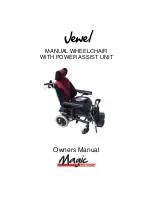
~ 8 ~
User manual
© 2013 VAN OS MEDICAL UK Ltd., Excel House, Escrick Business Park, Escrick,
York,YO19 6FD Tel. +44-(0)1904-720170, Fax +44-(0)1904-720398,
E-mail: sales@vanosmedical.com,
www.vanosmedical.com
Transferring
Transferring in a wheelchair is a difficult manoeuvre. Consult your physical therapist
for assistance in developing your individual technique. The possibilities you have for
making a transfer are depending on your physical characteristics. We advise you to
discuss this first with your physical therapist.
However if you have sufficient body strength and you want to transfer to and from
the wheelchair can you best do this in the following manner:
To get out of the wheelchair
:
First of all you must make sure that your wheelchair stands as closely as possible to
the place of where you wish to transfer to. Put the castors forward and engage the
brakes. Swing away the footplates and place your feet on the ground. You are now in
position to carry out the operation. Shift your weight to the front of the chair, you
can use the armrests as a support and move yourself to the place where you wish to
transfer to. If necessary you can use a transfer board.
To get in:
To get in your wheelchair you need to do the same things as when you want to get
out of the wheelchair, only in reversed order.
Reaching:
We strongly recommend that you seek the help of an attendant to pick something up
for you.
4.2 Negotiating pavements and unequal surfaces
Going up the pavement:
The attendant can help you in two different ways, however we advise you to do it
the first way.
1.
In the first method for going up a pavement you and the attendant reach to
pavement facing forward. The attendant must pull the push handles towards
him and place his foot on the stepper (see §2.1). When the attendant is
performing both procedures at the same time there will be a leverage effect
that tips the wheelchair, figure 2.
Figure 2
Summary of Contents for G-Lite Pro
Page 1: ......









































